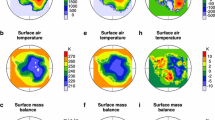Abstract
In the framework of the study of the Eemian interglacial we consider the role of the Greenland ice sheet in the rise of the mean level of the World Ocean. Its contribution estimated as 2 m confirms the newest estimates based on the model results and on the proxy data analysis. In the beginning of the Eemian interglacial (earlier than 126 thousand years ago) mass lost occurs through the marine margin of the sheet. During the next five millennia, the negative surface mass balance plays the leading role. Taking into account the contribution of Greenland ice sheet, ocean thermal expansion, and the melting of mountain glaciers and ice caps, it is very probable that the West Antarctic ice sheet was the main source of the global sea level growth equal to 6–9 m the compared to the present.
Similar content being viewed by others
References
O. O. Rybak, E. M. Volodin, and P. A. Morozova, “Reconstruction of Climate of the Eemian Interglacial Using an Earth System Model. Part 1. Set–up of Numerical Experiments and Model Fields of Surface Air Temperature and Precipitation Sums,” Meteorol. Gidrol., No. 6 (2018) [Russ. Meteorol. Hydrol., No. 6, 43 (2018)].
O. O. Rybak, E. M. Volodin, A. P. Nevecherya, and P. A. Morozova, “The Use of Energy Moisture Balanced Model to Include Cryosphere Component to the Climate Model. Part II. Model Mass Balance on the GrIS Surface,” Meteolᅳol. Gidrol., No. 6 (2016) [Russ. Meteorol. Hydrol., No. 6, 41 (2016)].
O. O. Rybak and F. Hobrechts, “Greenland Ice Sheet on the Peak of Warming of the Penultimate Interglacial,” Led i Sneg, No. 2 (2014) [in Russian].
J. L. Bamber, R. E. M. Riva, B. L. A. Vermeersen, and A. M. LeBrocq, “Reassessment of the Potential Sea–Level Rise from a Collapse of the West Antarctic Ice Sheet,” Science, 324 (2009).
A. Born and K. H. Nisancioglu, “Melting of Northern Greenland during the Last Interglaciation,” The Cryosphere, 6 (2012).
J. Chappell and N. J. Shackleton, “Oxygen Isotopes and Sea Level,” Nature, 324 (1986).
A. Dutton and K. Lambeck, “Ice Volume and Sea Level during the Last Interglacial,” Science, 337 (2012).
P. J. Hearty, J. T. Hollin, A. C. Neumann, et al., “Global Sea–level Fluctuations during the Last Interglacial (MIS 5e),” Quat. Sci. Rev., 26 (2007).
M. M. Helsen, W. J. van de Berg, R. S. W. van de Wal, et al., “Coupled Regional Climate–ice Sheet Simulation Shows Limited Greenland Ice Loss during the Eemian,” Climate of the Past, 9 (2013).
I. M. Howat, Y. Ahn, I. Joughin, et al., “Mass Balance of Greenland's Three Largest Outlet Glaciers, 2000–2010,” Geophys. Res. Lett., 38 (2011).
I. M. Howat, I. Joughin, and T. A. Scambos, “Rapid Changes in Ice Discharge from Greenland Outlet Glaciers,” Science, 315 (2007).
R. E. Kopp, F. J. Simons, J. X. Mitrovica, et al., “Probabilistic Assessment of Sea Level during the Last Interglacial Stage,” Nature, 462 (2009).
G. J. Kukla, M. L. Bender, J.–L. de Beaulieu, et al., “Last Interglacial Climates,” Quat. Rev., 58 (2002).
L. E. Lisiecki and M. E. Raymo, “A Pliocene–Pleistocene Stack of 57 Globally Distributed Benthic 518O Records,” Paleoceanography, 20 (2005).
N. P. McCay, J. T. Overpeck, and B. L. Otto–Bliesner, “The Role of Ocean Thermal Expansion in Last Interglacial Sea Level Rise,” Geophys. Res. Lett., 38 (2011).
J. H. Mercer, “West Antarctic Ice Sheet and CO2 Greenhouse Effect: A Threat of Disaster,” Nature, 271 (1978).
I. Nikolova, Q. Yin, A. Berger, et al., “The Last Interglacial (Eemian) Climate Simulated by LOVECLIM and CCSM3,” Climate of the Past, 9 (2013).
M. J. O'Leary, P. J. Hearty, W. G. Thompson, et al., “Ice Sheet Collapse Following a Prolonged Period of Stable Sea Level during the Last Interglacial,” Nature Geoscience, 6 (2013).
V. Radic and R. Hock, “Regional and Global Volumes of Glaciers Derived from Statistical Upscaling of Glacier Inventory Data,” J. Geophys. Res., 115 (2006).
A. Robinson, R. Calov, and A. Ganopolski, “An Efficient Regional Energy–moisture Balance Model for Simulation of the Greenland Ice Sheet Response to Climate Change,” The Cryosphere, 4 (2010).
J. Sutter, P. Gierz, K. Grosfeld, et al., “Ocean Temperature Thresholds for Last Interglacial West Antarctic Ice Sheet Collapse,” Geophys. Res. Lett., 43 (2016).
M. van den Broeke, J. Bamber, J. Ettema, et al., “Partitioning Recent Greentand Mass Loss,” Science, 326 (2009).
D. G. Vaughan and J. R. Spouge, “Risk Estimation of Col l apse of the West Antarctic Ice Sheet,” Climatic Change, 52 (2002).
Author information
Authors and Affiliations
Corresponding author
Additional information
Original Russian Text © O.O. Rybak, E.M. Volodin, P.A. Morozova, 2018, published in Meteorologiya i Gidrologiya, 2018, No. 6, pp. 33 0.
About this article
Cite this article
Rybak, O.O., Volodin, E.M. & Morozova, P.A. Reconstruction of Climate of the Eemian Interglacial Using an Earth System Model. Part 2. The Response of the Greenland Ice Sheet to Climate Change. Russ. Meteorol. Hydrol. 43, 366–371 (2018). https://doi.org/10.3103/S1068373918060031
Received:
Accepted:
Published:
Issue Date:
DOI: https://doi.org/10.3103/S1068373918060031




